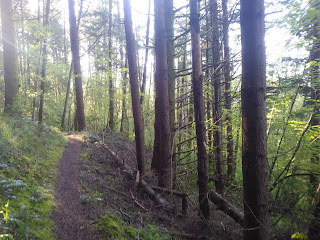I make this sound fun, don't I?
This weekend, I increased my distance by two miles and my elevation by 500 feet after having run the same distance for seven weeks with some easy weekends thrown in. I planned out a course in the Issaquah Alps (Tiger, Squak, and Cougar Mountains) that was supposed to be 22 miles according to Garmin Connect. According to my Garmin Fenix 5X, it was 24.52 partly due to me taking a wrong turn. But my planned 20 mile runs each turned out to be longer, too (22 miles and 21.5 miles), so I figured it was par for the course.
In an attempt to avoid sore quads and calves, I have been employing several tactics: trekking poles, downhill technique, hydration, and fueling (before, during, and after). Last week, I ran 12 miles on Squak Mountain with running poles for the first time. It took me a bit to get the hang of it (see previous post), but this weekend went much better. I have come to a few conclusions about running with poles:
- They are extremely helpful for moderate to steep climbs and steep descents.
- The most effective use uphill seems to be a motion that mimics the arm motion when you're on an elliptical. (I'm still working out good downhill technique.)
- It's best to put them in your pack if you're not going to be using them for a while. My shoulder fatigued yesterday because I had been carrying them both in my right hand for a long time.
- On easier climbs and easy to moderate descents, I prefer no poles.
- Not having your hands free is a bit of a pain. You can't look at your watch, drink, or eat while using poles.
- Planting a pole on the inside of a downhill switchback is a great and fun technique for getting around the corner swiftly.
Do they help? On the one hand, I can feel a little soreness in my quads today, but on the lower quads rather than the upper quads. A new experience is that my arms are tired. Carrying anything for a sustained time was hard today when normally I wouldn't notice it. My legs were a bit heavy for today's eight-mile run, but not bad considering yesterday's effort. Also, I ascended Tiger Mountain about a minute faster yesterday than the previous time I ran up it. Next week, I will do another 22-mile trail run and I will take just one pole to see how I like that. Overall, I think the poles help distribute the effort to the upper body, thereby lessening leg muscle soreness.
Pole updates: third run near end of post
I also tried out my fastpack vest. It needs some adjustments in the fit--I need to tighten up the side straps and loosen the front straps so that the two sides of the vest sit wider across my chest. It's not a women's specific pack, that's for sure! All in all, I don't think I'll have any issues with it, and my bear spray fit securely in one of the easily accessible front pockets. My vest and poles.
As for fueling and hydrating, I took more water than I ever have--about 40 ounces--for a run of seven hours. I tried something new in my water, Tailwind. I previously thought that it had protein that was vegan, but it turns out that that is their recovery drink. Nonetheless, I preferred Tailwind to Clif. There's not much in Clif, maybe 40 calories a serving. I used Endurox for my recovery drink, which is not vegan, and it upset my stomach. It has whey protein, which is supposed to be the best for recovery, but not being used to dairy, my stomach didn't like it and I found the taste unpleasant. To me, it had an aftertaste a little like sour milk. I just bought a huge container of it, too. I plan to get some Tailwind recovery drink instead.
One last update is regarding my watch. When I ran on Squak Mountain last week, I was certain that I was following the magenta marked course, but it was no course I had ever created so I was baffled. This weekend, I figured it out! When you get off course, the Fenix 5X will route you a new course to get you back on track. I think I like that feature. I just wish it could be a different color so that you would know you were off course but on track to get back on course...but not actually on your planned route.
Coming up, I'll sew the screen on my bivy and write my article for Backpacking Light about making my own bivy. I have abandoned my plans so far for training on other parts of the PCT because the elevation gain is too slight. But I hope to put the bivy to use before June is over.





































